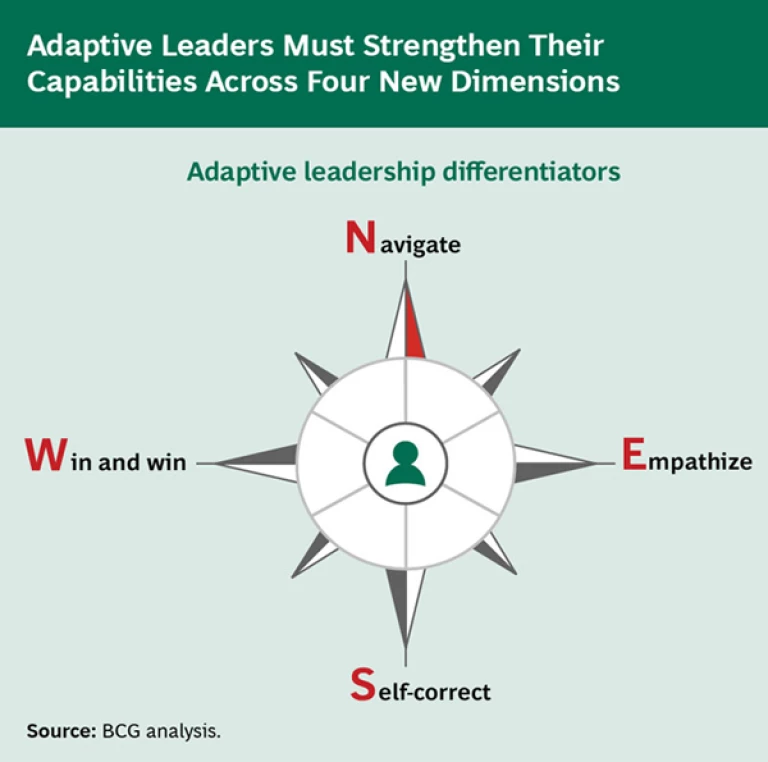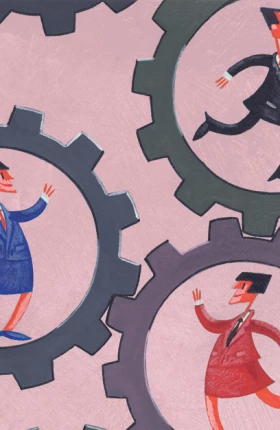We commonly think of leaders as strong personalities who have a vision and set the course for the organizations they lead. But leaders increasingly find this view lacking. In his essay “ The Globally Integrated Enterprise ,” Sam Palmisano, Chairman of IBM, explained “Hierarchical, command-and-control approaches simply do not work anymore. They impede information flows inside companies, hampering the fluid and collaborative nature of work today.”
This observation is particularly true for public-sector organizations in today’s environment, which encourages leaders to be both averse to risk and highly responsive to change. Public-sector leaders often work against a backdrop of unexpected political and policy changes and crises. In addition, their roles may be further constrained by the term limits they face as political appointees or elected officials. Their organizations also face pressure to offer increasingly complex services and to adapt to new technologies—all while subject to high levels of public accountability and scrutiny. A traditional command-and-control approach ignores the realities of the current climate and the needs of teams that often remain long after politics and policy have left their mark. (See “Adaptive Leadership Can Help Ease ‘Change Whiplash’ in the Public Sector,” below.)
Adaptive Leadership Can Help Ease “Change Whiplash” in the Public Sector
Governments with shorter electoral cycles can suffer from a “change for the sake of change” mentality, or “change whiplash.” Incoming leaders may ask themselves several of the following questions.
What change can I implement quickly to differentiate my time in office from that of my predecessor?
Public-sector leaders often serve limited terms, particularly if they are elected officials or political appointees. This can lead to short-term, policy-only change agendas rather than deep reforms that address infrastructure- or capability-building needs. Leaders in this position too often think:
Why adapt to the existing organization when I have so little time to make an impact?
The leadership teams that outlive various administrators’ limited “regimes” often rely on survival skills and become exhausted by the regular cycles of redirection. In other words, they unlearn adaptivity. They wind up saying to themselves:
Why adapt when I know the next leader will change direction yet again?
Short-term leaders and their long-term staffs have inverse requirements and incentives. Adaptive leadership can break the vicious circle by deploying two adaptive leadership attributes.
- Appointed leaders should focus on having empathy for tenured leaders and their needs and a willingness to build platforms for transparent collaboration that invite a diversity of perspectives.
- Tenured leaders must embrace adaptivity themselves, welcoming the accountability that comes with shared leadership and delivering on shorter-term, high-priority policy requirements while championing courageously for the longer-term needs.
Our research and experience suggest that the fundamental shifts in today’s environment compel us to rethink the nature of strategy, organization, and consequently, leadership.
Consider the following trends:
Turbulence and uncertainty have undermined the effectiveness of long-range forecasting and traditional strategic planning.
How can leaders chart a course when they can't predict the outcomes of their choices?
Government agencies are increasingly interdependent—and often have overlapping missions or scope.
When boundaries are blurred, who leads whom?
The pervasiveness of digital communication and technology has made every organization an information organization.
In such an environment, how can leaders ensure that their organizations are reading the right signals and acting on them?
The pressure on public services is intensifying as populations age, expectations rise, and resources become more stretched.
How can leaders build up society’s trust in public organizations? How can they harness the creativity and passion of the workforce to deliver more from the same resources?
Some environments are mature and predictable, while others are highly uncertain.
How do leaders ensure that they are taking the right approach—or the right mosaic of approaches—for the specific challenges at hand?
These shifts call for adaptive strategies and organizations, and they require leaders to become adaptive as well. Adaptive leaders create conditions that engage employees at all levels of the organization and enable them to achieve common goals particularly in an environment of uncertainty.
Dimensions of Adaptive Leadership
There are four dimensions to leadership that distinguish the adaptive leadership model from more traditional leadership models: navigating a new environment; leading with empathy; learning through self-correction, and creating win-win solutions. (“ New Leadership Rules ” BCG White Paper, May 2010.)
Navigating the New Environment. Nelson Mandela once said, “[T]he ways in which we will achieve our goals are bound by context, changing with circumstances even while remaining steadfast in our commitment to our vision.” Adaptive leaders must embrace uncertainty and adopt new approaches if they are to chart a course amid today’s turbulent conditions.
- Manage the context in which actors interact, not the rule book. Amid uncertainty, rigid rules can be counterproductive as they often force managers and frontline workers to be driven by compliance rather than results. The adaptive leader sets priorities and objectives and makes managers and frontline workers responsible and accountable for achieving those desired outcomes. In the education sector, for example, some of the strongest-performing school systems handed responsibility for the performance of individual schools to their principal or school leader, empowering them to make decisions based on the particular needs of their school and its students.
- Cultivate a diversity of perspectives to generate a multiplicity of options. Traditional models of leadership may emphasize compliance, but adaptive leadership styles de-emphasize hierarchy and make dissenting opinion compulsory. Adaptive leaders take into account the perspectives of workers, who are responsible for delivering frontline public services and are most likely to raise critical questions about external realities.
- Allow leadership to be shared and to emerge from the given context. In a volatile world, no single person can lead at all times and in all situations. The role of the leader should be assumed by the person that is in the best position to guide or make decisions. In the public sector, a model of shared leadership should be considered as well, particularly for divisions or departments with politically appointed leadership. This type of model promotes consistency and allows for changes to become fully realized.
- Constantly question the world around you. Adaptive leaders are always looking outward and realigning their organizations with the shifting environment. They read between the lines, intuitively grasp patterns that may be masked by complexity, and test their own assumptions by running through “what if” scenarios. For example, a secretary or director-general may periodically ask, “If I move on and the minister brought in someone new, what do I think they would do in my shoes?” This is a critical process in the public-sector setting, since electoral cycles can mean regular change both for elected leaders and leaders at senior levels in the bureaucracy, who may be political appointees.
Leading with Empathy. Adaptive leaders create a shared sense of purpose and manage through influence rather than command and control.
- See the world through the eyes of others. By understanding alternative perspectives, adaptive leaders cultivate and embrace the cognitive diversity that underpins adaptive organizations. Their ability to empathize with colleagues and other stakeholders enables them to exert influence across boundaries. By seeing the world through the eyes of others, these leaders also extend their ability to see patterns in a complex environment.
- Create a shared sense of purpose. Relative to private-sector companies, public-sector organizations have an amplified emphasis on mission since their critical focus is serving the public, and this must be reflected in the shared values of everyone in the organization. Adaptive leaders identify the shared purpose and work out how to harness it and empower employees to deliver results. For example, the crime division of a state police department wanted to be able to solve crimes more quickly and successfully. It needed to be more agile and more able to rapidly reallocate the police resources assigned to particular crimes or threats at a given moment. To do this, many police officers in the division needed to develop a more generalist skill set rather than deep specialization in particular types of crimes. The challenge was getting everyone in the department to change their mindset and focus on the goals of the department rather than the goals of the squad or specialized unit.
- Reward accomplishment with autonomy. Adaptive leaders reward people for what they accomplish, rather than tracking hours or tasks. Public-sector leaders must motivate employees with nonfinancial rewards, such as giving employees time to pursue causes that are of interest to them and that further the mission of the organization. Adaptive leaders understand that real commitment comes from individual opportunities for autonomy, mastery, collaboration, and recognition.
Learning Through Self-Correction. Adaptive leaders encourage—indeed insist on—experimentation by creating safe, no-risk environments internally. Of course, some experiments will fail, but that is how adaptive organizations learn.
- Enable individuals and teams to learn through experimentation. Adaptive leaders need to develop platforms that enable experimentation and learning, including opportunities to reflect on successes and failures. Leaders should also align rewards with experimentation in a way that doesn’t punish “failure.” Many government organizations tend to shy away from innovation. But the government of Singapore has demonstrated how to foster a culture that is open to change and innovation through its “ Public Service for the 21st Century ” movement. The program empowers individual public-sector officers and self-organizing teams to initiate changes, improvements, and innovations from the ground up, while management is obliged to consider suggestions and proposals.
- Develop your organization’s “signal advantage.” In a changing environment, organizations have to detect, filter, and decode signals in order to anticipate and respond to what’s coming next. This can be a challenge for cumbersome bureaucracies. Leaders should ensure that their organizations are constantly looking outward and staying close to their constituents and stakeholders. In many cases, this means developing an internal risk-management function that can formalize the practice of observing, understanding, and mitigating mission, operational, and financial risks.
- Increase the agility with which the organization is able to correct itself. Adaptive leaders minimize the number of layers between the field and the leader and allow decisions to be made at all levels in the organization. As retired U.S. General Stanley McChrystal told The Atlantic , “Any complex task is best approached by flattening hierarchies. It gets everybody feeling like they’re in the inner circle, so that they develop a sense of ownership.”
Creating Win-Win Solutions. Adaptive leaders focus on sustainable success for both the organization as well as its external network of stakeholders.
- Build platforms for collaboration. For many government organizations, success depends on the engagement of other government agencies and entities—and may require collaboration across different geographies. Technology now makes it possible for large groups to collaborate on complex tasks. Strong adaptive leadership can help empower employees to collaborate effectively: The Australian government, for example, launched a collaboration initiative called GovDex to enable government agencies and third parties to share documents and information, author collaboratively, manage tasks and issues, and engage with project stakeholders.
- Deploy leadership influence beyond the boundaries of the organization. In the absence of formal authority, leaders must structure their interaction for win-win outcomes and use “soft power” such as vision, charisma, networking, and collaboration to exert influence. This will help public-sector leaders mobilize their wide-ranging network of stakeholders and others with aligned interests.
Modulating the Leadership Model
Unpredictable environments will require different leadership styles like those characterized above. Not all environments or challenges are alike, however. Just as different organizational models are needed for different environments, so too are different leadership styles. Over time, an organization might move from one leadership archetype to another—for example, during periods of major policy reform, stable organizations can be disrupted, and a shift to a more experimental style may be more effective. Or when an organization is facing a period marked by more stable policies and less reform, then a more deliberate, analytical style may be optimal. When an organization is not yet adaptive but needs to become more so, strong individual leadership may be required initially to disrupt the status quo—but might later give way to a more collaborative style.
There is no universal checklist for adaptive leadership, but leaders who are focused on the four dimensions we’ve described will be better equipped for a turbulent and unpredictable environment. To gauge how adaptive your leadership model is, ask yourself and your leadership teams just three questions about what you are doing and how you are thinking as leaders:
- How many of the adaptive leadership practices cited above do we currently employ?
- Do we have the right leadership model for our specific environment?
- What changes could we make to develop a more adaptive leadership model?
We conclude with a quote from John Clarkeson, former CEO of BCG, who presciently and vividly sketched this new model of leadership 20 years ago in a BCG Perspective titled “ Jazz vs. Symphony ”:
Leadership will flow to those whose vision can inspire the members of the team to put their best abilities at the service of the team. These leaders will create rather than demand loyalty; the best people will want to work with them. They will communicate effectively with a variety of people and use the conflict among diverse points of view to reach new insights. They will exert influence by the values they choose to reinforce. They will make leaders of their team members.










